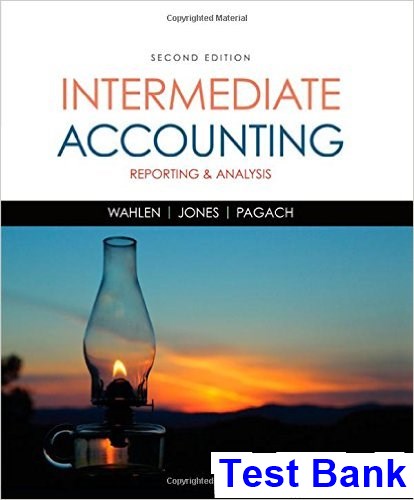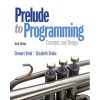Intermediate Accounting Reporting and Analysis 2nd Edition Wahlen Test Bank
$35.00 Original price was: $35.00.$26.50Current price is: $26.50.
Intermediate Accounting Reporting and Analysis 2nd Edition Wahlen Test Bank
Intermediate Accounting Reporting and Analysis 2nd Edition Wahlen Test Bank

Product details:
- ISBN-10 : 1285453824
- ISBN-13 : 978-1285453828
- Author: James M. Wahlen
Wahlen/Jones/Pagach’s INTERMEDIATE ACCOUNTING, 2E and CengageNOWv2 help you understand and manage the rigor and time requirements of the Intermediate course before that first exam. And, at the same time, other resources help you keep on track, building confidence in your own knowledge and mastery, helping you succeed. All of this is accomplished without sacrificing the book’s approachable writing style that uses recognizable, familiar companies such as an ongoing Starbucks case, and examples from familiar companies, such as Coca Cola, Louis Vuitton, and Nestle. This edition presents the latest information on the new Revenue Recognition Standards.
Table contents:
- Part 1: Financial Reporting & Statements: Objectives, Concepts, & Analysis
- Ch 1: The Demand for and Supply of Financial Accounting Information
- Ch 1: Learning Objectives
- Ch 1: Introduction
- Why Does the World Need Financial Accounting Information?
- The Supply of Financial Accounting Information
- The FASB
- FASB Accounting Standards Codification
- The IASB and IFRS
- What Is the Product? Financial Reporting and the Financial Statements
- Why Is Accounting Important? The Economic Consequences of Financial Reporting
- Ch 1: Review Center
- Ch 1: Exercise
- Ch 1: Cases
- Ch 2: Financial Reporting: Its Conceptual Framework
- Ch 2: Learning Objectives
- What Is the FASB’S Conceptual Framework?
- What Are the Objectives of Financial Reporting?
- What Qualities Make Accounting Information Useful?
- What Are the Most Important Assumptions in Accounting?
- What Is the Financial Reporting Model in the Conceptual Framework?
- Ch 2: Review Center
- Ch 2: Multiple-Choice (AICPA Adapted)
- Ch 2: Exercises
- Ch 2: Cases
- Ch 3: Review of a Company’s Accounting System
- Ch 3: Learning Objectives
- What Are the Components of an Accounting System?
- What Is the Accounting Cycle?
- How Do We Record Entries in the General Journal (Step 1)?
- How Do We Post to the General Ledger (Step 2)?
- How Do We Prepare Adjusting Entries (Step 3)?
- How Do We Prepare Financial Statements (Step 4)?
- How Do We Prepare Closing Entries (Step 5)?
- How Do We Use a Worksheet to Prepare Financial Statements?
- What Is the Purpose of Reversing Entries?
- How Do We Use Subsidiary Ledgers and Special Journals?
- Appendix 3.1: What Is Cash-Basis Accounting?
- Ch 3: Review Center
- Ch 3: Review Exercises
- Ch 3: Problems
- Ch 4: The Balance Sheet and the Statement of Shareholders’ Equity
- Ch 4: Learning Objectives
- What Is the Purpose of the Balance Sheet?
- What Elements Are Recognized on the Balance Sheet?
- How Are the Elements of a Balance Sheet Measured?
- How Are Items Classified and Reported on the Balance Sheet?
- What Is the Statement of Shareholders’ Equity?
- Additional Balance Sheet Disclosures
- How Do We Analyze Balance Sheet Information?
- How Does Balance Sheet Classification and Presentation Differ Under IFRS versus U.S. GAAP?
- Answers to Real Report Questions
- Ch 4: Multiple-Choice (AICPA Adapted)
- Ch 4: Review Exercises
- Ch 4: Exercises
- Ch 4: Problems
- Ch 4: Cases
- Ch 5: The Income Statement and the Statement of Cash Flows
- Ch 5: Learning Objectives
- What Are the Purposes of the Income Statement?
- What Is Income?
- What Are the Elements of the Income Statement?
- What Are the Major Components of the Income Statement?
- How Do Income Statements Report Results from Discontinued Operations?
- How Do We Compute and Report Earnings Per Share?
- How Do Companies Report Comprehensive Income?
- U.S. Gaap Versus IFRS: Similarities and differences in Reporting Income
- How Do We Analyze the Information in Income Statements and Cash Flow Statements?
- Appendix 5.1: Segment and Interim Reporting
- Ch 5: Review Center
- Ch 5: Answers to Real Report Questions
- Ch 5: Multiple-Choice (AICPA Adapted)
- Ch 5: Review Exercises
- Ch 5: Exercises
- Ch 5: Problems
- Ch 5: Cases
- Time Value of Money Module
- Learning Objectives
- What Is the Time Value of Money?
- How Do We Compute the Future Value of a Single Sum?
- How Do We Compute the Present Value of a Single Sum?
- What Are Annuities?
- How Do We Compute the Future Value of an Ordinary Annuity?
- How Do We Compute the Future Value of an Annuity Due?
- How Do We Compute the Present Value of an Ordinary Annuity?
- How Do We Compute the Present Value of an Annuity Due?
- How Do We Compute the Present value of a Deferred Annuity?
- Summary of Present and Future Value Calculations
- How Do We Use Present Value Techniques in Financial Reporting?
- Review Center
- Multiple-Choice (AICPA Adapted)
- Review Exercises
- Exercises
- Problems
- Cases
- Compound Interest Tables
- Part 2: Business Operating Activities
- Ch 6: Cash and Receivables
- Ch 6: Learning Objectives
- What Is Cash?
- Why Do Businesses Need Cash Controls?
- What Are the Different Types of Receivables?
- How Are Accounts Receivable Recorded?
- How Are Uncollectible Accounts Receivable Estimated?
- How Do Companies Account for the Financing of Accounts Receivable
- How Do Companies Account for Notes receivable?
- How Are Receivables Disclosed?
- Ch 6: Review Center
- Ch 6: Answers to Real Report Questions
- Ch 6: Multiple-Choice (AICPA Adapted)
- Ch 6: Review Exercises
- Ch 6: Exercises
- Ch 6: Problems
- Ch 6: Cases
- Ch 7: Inventories: Cost Measurement and Flow Assumptions
- Ch 7: Learning Objectives
- How Do Companies Classify Inventory?
- How Do Companies Keep Track of Inventory?
- How Do Companies Determine Inventory Quantities?
- How Do Companies Determine Inventory Costs?
- What Are the Different Cost Flow Assumptions?
- What Are the Consequences of Using Alternative Inventory Cost Flow Assumptions?
- How Do Companies Disclose Inventory Values and Methods?
- Ch 7: Review Center
- Ch 7: Answers to Real Report Questions
- Ch 7: Multiple-Choice (AICPA Adapted)
- Ch 7: Review Exercises
- Ch 7: Exercises
- Ch 7: Problems
- Ch 7: Cases
- Ch 8: Inventories: Special Valuation Issues
- Ch 8: Learning Objectives
- What Is the Lower of Cost or Market Rule?
- How Is Inventory Estimated Using the Gross Profit Method?
- How Is Inventory Estimated Using the Retail Inventory Method?
- What Is the Dollar-Value Retail Method?
- What Are the Effects of Inventory Errors?
- Appendix 8.1: Application of Lower of Cost or Market in a Periodic Inventory System
- Ch 8: Review Center
- Ch 8: Answers to Real Report Questions
- Ch 8: Multiple-Choice (AICPA Adapted)
- Ch 8: Review Exercises
- Ch 8: Exercises
- Ch 8: Problems
- Ch 8: Cases
- Ch 9: Current Liabilities and Contingent Obligations
- Ch 9: Learning Objectives
- What Are Liabilities?
- What Is a Current Liability?
- How Do You Account for Current Liabilities Based on a Contractual Amount?
- How Do We Account for Current Liabilities with Amounts Determined By Operating Activities?
- How Do We Account for Contingent Obligations?
- Ch 9: Review Center
- Ch 9: Answers to Real Report Questions
- Ch 9: Multiple-Choice (AICPA Adapted)
- Ch 9: Review Exercises
- Ch 9: Exercises
- Ch 9: Problems
- Ch 9: Cases
- Part 3: Investing Activities
- Ch 10: Property, Plant, and Equipment: Acquisition and Subsequent Investments
- Ch 10: Learning Objectives
- What Are the Characteristics of Property, Plant, and Equipment?
- How Do We Account for the Acquisition of Property, Plant, and Equipment?
- What Is the Cost of Self-Constructed Assets
- Appendix 10.1: Oil and Gas Properties
- Ch 10: Review Center
- Ch 10: Answers to Real Report Questions
- Ch 10: Multiple-Choice (AICPA Adapted)
- Ch 10: Review Exercises
- Ch 10: Exercises
- Ch 10: Problems
- Ch 10: Cases
- Ch 11: Depreciation, Depletion, Impairment, and Disposal
- Ch 11: Learning Objectives
- What Are the Factors Involved in Depreciation?
- What Are the Methods of Cost Allocation?
- Conceptual Evaluation of Depreciation Methods
- What Additional Depreciation Methods Exist?
- How Are Depreciable Assets Disclosed?
- What Are Some Additional Issues Related to Depreciation?
- How Do We Account for the Impairment of Property, Plant, and Equipment?
- How Is Depletion Recorded?
- Appendix 11.1: How Is Depreciation Calculated for Income Tax Purposes?
- Ch 11: Review Center
- Ch 11: Answers to Real Report Questions
- Ch 11: Multiple-choice (AICPA Adapted)
- Ch 11: Review Exercises
- Ch 11: Exercises
- Ch 11: Problems
- Ch 11: Cases
- Ch 12: Intangibles
- Ch 12: Learning Objectives
- How Do We Account for Intangible Assets?
- How Do We Account for Research and Development Costs?
- How Are Intangible Assets Disclosed?
- Identifiable Intangible Assets
- How Do We Account for Unidentifiable Intangibles?
- Ch 12: Answers to Real Report Questions
- Ch 12: Multiple-Choice (AICPA Adapted)
- Ch 12: Review Exercises
- Ch 12: Exercises
- Ch 12: Problems
- Ch 12: Cases
- Ch 13: Investments and Long-Term Receivables
- Ch 13: Learning Objectives
- How Are Investments Classified and Reported?
- How Are Investments in Held-To-Maturity Securities Measured and Reported?
- How Are Investments in Trading Securities Measured and Reported?
- How Are Investments in Available-for-Sale Securities Measured and Reported?
- How Do We Account for Transfers and Impairments?
- How Do You Account for Minority Active Investments?
- What Is the Accounting for Other Types of Investments?
- Appendix 13.1: Derivative Financial Instruments
- Ch 13: Review Center
- Ch 13: Answers to Real Report Questions
- Ch 13: Multiple-Choice (AICPA Adapted)
- Ch 13: Review Exercises
- Ch 13: Exercises
- Ch 13: Problems
- Ch 13: Cases
People also search:
intermediate accounting reporting and analysis 2017 update 2nd edition
what is intermediate accounting 2
intermediate accounting 2 summary
what is intermediate accounting
intermediate accounting 1 vs 2
Related products
Test Bank
Test Bank for Decision Support and Business Intelligence Systems, 9th Edition: Efraim Turban











